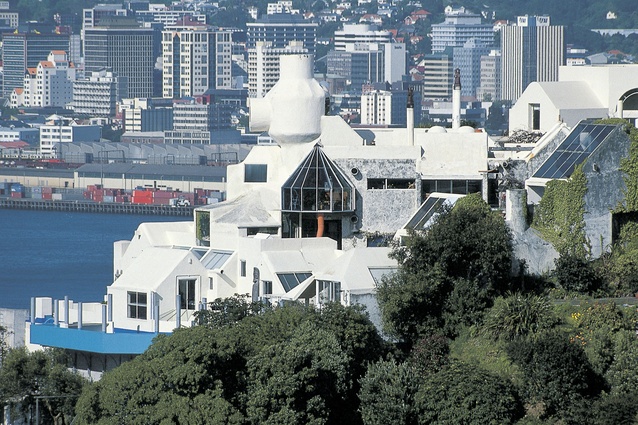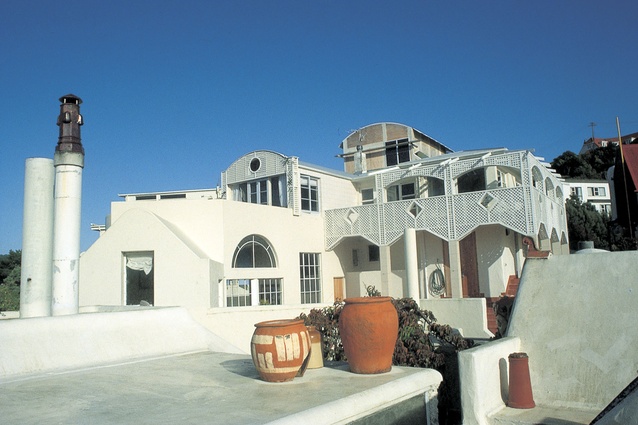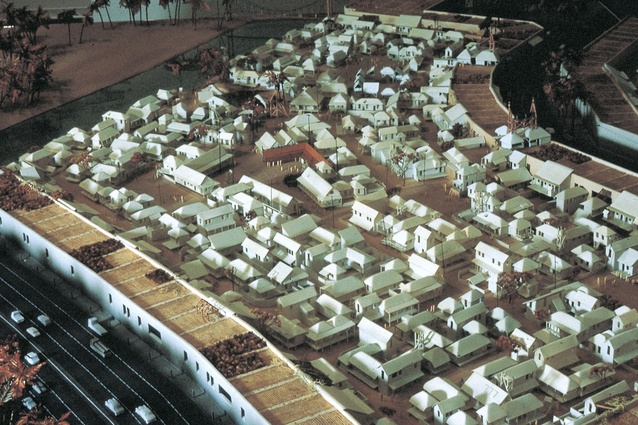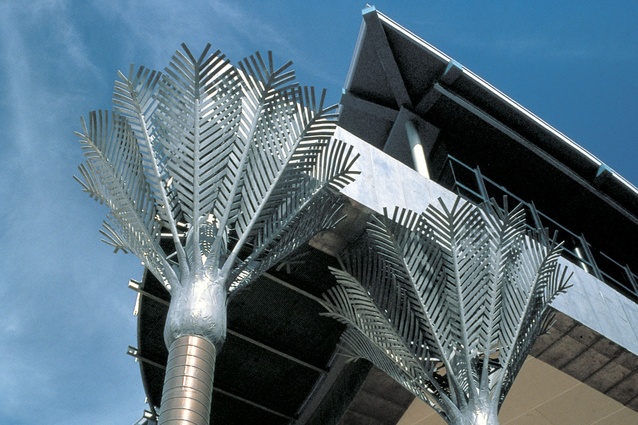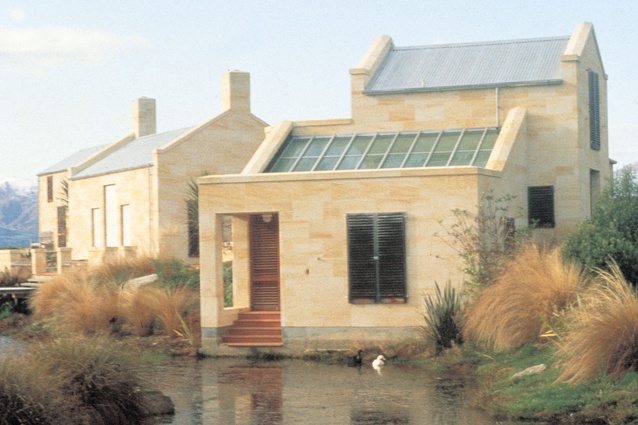NZIA 2004 Gold Medalist: Ian Athfield
Sir Ian Athfield (1940-2015) was the 2004 recipient of the NZIA Gold Medal, the highest honour bestowed by the New Zealand Institute of Architects for an outstanding contribution to the practice of architecture, demonstrated through the production of a consistently high-quality body of work over a period of time.
In March 2004, Ian Athfield was interviewed for Architecture New Zealand by Tony van Raat. In this republished article, Sir Ian talked about his education, his career and its turning points, and the evolution of New Zealand architecture’s most extraordinary house.
Ian Athfield is a huge personality in New Zealand architecture. Throughout his highly productive career, which now spans four decades, he has generated work that is accomplished and often provocative. He has had a profound influence on the built environment of this country, especially in Wellington. More than that, he has been instrumental in raising public awareness and public expectations of the work of architects and the possibilities of architecture.
Athfield grew up in Christchurch, a city with a strong architectural tradition characterised by coherence rather than diversity. Though he was hardly in the mainstream of that lineage it is significant that Athfield has been able to maintain links to Christchurch; Jade Stadium (Supreme New Zealand Award, 2003), for example, marked a triumphant return to his native city.
As a student at the Architecture School at Auckland University, Athfield was immediately noticeable. An enterprising proponent of unusual schemes, already it was apparent he would go his own way, and his career has continued to follow a singular, though never a straight-and-narrow path. Initially, he designed buildings that, in the manner of Christchurch and the South Island, were quite conservative. It was when he came to design his own house above Wellington harbour that another Athfield was revealed.
The house is fundamentally important to Athfield’s life and work. The tumbling white palace is, in New Zealand, a unique achievement: part family house; part office; almost a village. It is Athfield’s continuing autobiography, a very-public diary that records an individual, idiosyncratic architectural journey. The house exemplifies Athfield’s partiality for designing in an expressive mode; in architecture, no less than in person, Athfield is a wonderful performer. He has always been conscious, and unafraid, of a public audience. From the start, the house was a successful advertisement for himself, and for the figure of the Architect in a city where people have a close interest in architecture.
Athfield’s architecture is stimulating, challenging, ever-changing, but never careless. The architecture, like the man, evades typecasting. Since he established his own practice in 1968 he has always been prepared to experiment; he has embraced all sorts of architectural manners. This eclecticism, like the hirsute appearance of his earlier days, masks a formidable sense of purpose. Institutional clients have always appreciated that he produces results. From public projects, such as Wellington’s Public Library and Civic Square and the Nelson Polytechnic Library, to commercial buildings, such as the Hewlett Packard Building and Telecom House, to private residences such as the Buck and Custance Houses, he has exhibited mastery on all the fronts on which New Zealand architects operate.
What defines Athfield above all is his contagious enthusiasm, his devotion to architecture, and his unswerving belief in its possibilities. Believing architecture to be a civilising force, he has demonstrated a strong commitment to architecture’s public realm: the streets we live in; the urban centres we inhabit; the countryside we love and so often abuse. Athfield has stepped into areas which New Zealand architects have not previously occupied. For him, urban design is not primarily a site for architectural performance, but a social ground.
It is impossible to separate Athfield and his vocation. He is complex, socially-oriented, and thoroughly engaging. In numerous projects he has drawn on his ample reserves of confidence — Wellington’s First Church of Christ Scientist, for example, is testament to his audacity. He possesses in abundance that rarest of human qualities: the ability to inspire courage in others.
Athfield’s contribution to architecture and to his society has received widespread recognition. His practice has gained more than 60 design awards, including 13 NZIA National (now Supreme New Zealand) Awards, and his work has been published extensively, both in New Zealand and abroad. Athfield has served on NZIA National juries, and has delivered keynote addresses at several international architectural conferences. He continues to take a leading role on urban design groups throughout New Zealand. In 1986, he was appointed inaugural Professional Fellow at Victoria University’s School of Architecture, where has been a tutor and critic; in 2000, Victoria University awarded him an Honorary Doctorate in Literature. The University of Auckland named Athfield as an Alumni Fellow in 1997. In 1996 the New Zealand Government made him a Companion to the New Zealand Order of Merit. NZIA
Tony van Raat: Why architecture?
Ian Athfield: Well, I suppose I was lucky. My mum decided what my brother and I were going to be. We had a boarder at our house in Christchurch called Jim Ashby and he said that I seemed to be very good at mathematics and drawing and Tony seemed to have some musical attributes. So mum decided that I should be an architect and my brother should be a musician, and she worked hard at achieving those things.
TVR: Were there any architects in Christchurch who were useful in giving you an idea of what architecture might involve?
IA: Christchurch was quite important at that time, in 1959-60. There was Miles Warren, Peter Beaven, and a whole group of other people who had an empathy with those two — a whole series of people who were enthusiastic. There was a new spirit in Christchurch. After work I’d go down to Peter Beaven’s office to see the latest of Peter’s designs and then call into Miles Warren’s office. It wasn’t entirely traditional either — I remember when they floated Miles down the river in the bathtub. And he wore black and white leotards at the time. Then I took all the money I had saved and blew it by going to the school of architecture.
TVR: How was that?
IA: I had come from the technical side so I was among the downgraded students. The degree students got all the scholarships and the overseas trips and the diploma course was on the other side. We got the worst lecturers, we had the best fun, and we got into the most trouble. It was a time when people were conscious about position and place. Most of our time was spent drinking far too much and not playing the established game. I did reasonably well at [the] School. We never got the good teachers but they saw what we were doing. Gordon Smith and Dick Toy, Vernon Brown — we had them for general lectures but not for studio work. We got the riff-raff. It was a system that brought out the worst and the best in us. Sometimes it worried us, seeing the degree students move ahead while we had to get recounts and had to go and ask if we could get through.
TVR: Did you work in an architect’s office during the vacations?
IA: Yeah, I worked for Miles Warren. He was good to me. He appreciated that I could draw. I understood a bit about construction and he gave me a set of working drawings to do while I was at the school of architecture and that was quite a trusting thing.
TVR: Miles has always valued the ability to draw, hasn’t he?
IA: Yeah, and it was amazing going into Miles’ office, the incredible discipline. I remember the first job I drew up and Miles said ‘You can’t draw those as six inch walls’. I said, ‘No, they are four inch walls’. ‘No’, he said, ‘they’re six inches’. Now this was on a one-to-a-hundred drawing and afterwards I said to someone ‘How can he tell the difference?’ They said, ‘He knows everything’. Then he saw my lettering and said, ‘You can do the drawing, Ath, but someone else can do the lettering’. It’s got presentable since then. You learn architecturally how to produce lettering which is totally illegible but it looks alright on paper.
TVR: What did you do then?
IA: Stephenson & Turner had a job [in Auckland] which I accepted and in the first week I had an accident on the Harbour Bridge with the senior partner’s car. I was in my car and I hit him while travelling home quickly to change for the office Christmas party … He was a bit dismayed when he discovered it was a person he had just employed. Then I was offered a job in Wellington with Structon Group, with a partnership in three years if I accepted. So I did. We had a lot of interesting people and we worked hard together. It was a really great time and I was a partner until the 15th July 1968.
TVR: Obviously a date that’s engraved in your memory.
IA: Well, it was my birthday as well as the day that I got dismissed for contravening section 20C of the partnership agreement which states that if any three senior partners agree that you’ve acted in contradiction of the partnership agreement you can be dismissed immediately. I was completely unaware of that because in the previous couple of weeks I had tried to introduce a retirement policy for the senior partners. I was 28 and the next junior partner was 41 and there was a series of partners sitting around 65. To introduce a retirement policy was a bit lethal at the time …
I got the notice at 12 o’clock. I was a bit late in going down to the pub. We always used to go down to the Grand Hotel for lunch at Structon; have a few beers, pretty stodgy food, talk about architecture, talk about girls, talk about sport, you know … And just as I left my room the senior partner said to me ‘Ath, there’s a notice on the receptionist’s bench. You’d better read it’.
Well, I went down to the pub, shed a few tears and said to the guys ‘Well that’s it, boys. I’m dismissed’. They said ‘What are you going to do now?’ I said, ‘Well, I’ll have to rescue my life, won’t I, and quickly’. So … I went around all the clients I was working for and said ‘I’ve just been dismissed. If you’ve got anything you want to hand to me that’s fine but I won’t be at Structon any longer’. That night I went back to the office at about 12 o’clock, grabbed as much tracing paper as I could carry, left with a liftful of stuff and started practising the next day from home.
TVR: Do you have any sense that architectural education pays enough attention to the business of making?
IA: I’ve struggled with that. I had the advantage of teaching for a couple of years which I frankly really enjoyed. I would like to do a bit more of it, but at the time I was disappointed by fellow teachers who were far too lazy and really didn’t give students a direction. You know, architecture is putting things together, it’s understanding the materials and not just the materials which we have today but the whole history of construction, and a social history as well as a built history. We look at the end result too much rather than the processes.
TVR: You’ve tested quite a bit on your own house …
IA: Oh yeah, my own house hasn’t been a very good thing for getting new clients. None of them actually understand what it’s about. To them it’s an unfinished bloody mess. But, you know … it’s probably in some ways the most important thing I’ve done.
TVR: It’s been the longest project, hasn’t it?
IA: Yeah, it has. It started in ’65 and it’s still going and it’ll never be finished, although I’ve promised my family I’ll finish it. But it’s the best example of infill housing in the country. It’s good infill housing because it’s an appropriate response to how suburbia has to change. You actually have to build on the accidents of the past, on the physical environments which got created because something happened. You can’t ignore them.
TVR: Is the house too loose to be iconic, too hard to define?
IA: Yeah. The builders just added a great piece. Clare [Cookson, Ian Athfield’s wife] hasn’t been terribly well and was in hospital so I thought I had the opportunity of demolishing an end of the kitchen, so we demolished it. But she got well so quickly that, when she came out of hospital, the builders put up a temporary roof at the end of the kitchen, and I just looked at that and thought, ‘F… that’s better than anything I’ve done for a long time’. It reminded me so much of the Philippine squatter housing which we went through, that whole thing of salvage plywood, lean-to civilisation right on the edges, things propped up against each other. Here’s this sort-of permanent house hacked away and a lean-to put on it. It looks great, absolutely. But you’d have to be really brave to leave it there because if I did my family would leave me. But the incomplete structure is always better than the completed thing.
TVR: You’re always extremely entertaining and somebody said that you were the Billy Connelly of architecture in New Zealand. At the same time you’re extremely serious about the production of work. But do you think that your work would have benefited from more rigorous critique and analysis, and do you clown about your work in public in order to deflect that?
IA: I don’t necessarily want to be taken seriously. I want to deflect people from my work and think of other things. I don’t want to fall into the area of self-consciousness where all of a sudden I’m starting to analyse myself and why I do things. Sometimes you actually feel you’re getting trapped and it’s better not to be trapped.
TVR: Have people written well about your work?
IA: I don’t care. It’s not very important for me. Architects have got an incredible role to play in educating the public in an unknown area, so I see myself as part of an educational process. I see myself as a person who will question ideas, who will stimulate some people and anger others.
TVR: Who have been the architects who have been significant to you?
IA: I don’t actually ever think of it like that, but I do like working with other architects, I’m enjoying working with a number of them at the moment — Patrick Clifford, Pip Cheshire — and I’m working a little bit with Miles at present.
TVR: Do you think there is any point in trying to distinguish between building and architecture? Do the two words have different significance for you?
IA: No. I think that architecture is about being snobbish about what is pretty basic. There are a lot of people who build better than architects, that’s definite.
Do you read the magazines? Are they important to you?
IA: No.
TVR: Should young architects read the magazines or not?
IA: Well they can, but the difficulty is that you can be affected by so many other things. In my most difficult period I was influenced by Roger Walker. People saw us as competitors, and that affected our friendship which is unfortunate because we were working in different ways, both of which were quite valid.
It doesn’t help you to emulate someone else although you do need to have an open mind to a whole lot of other things. I mean, I like seeing magazines, I think, ‘Christ that’s f…… good, I wish I could do it like that’. The other day I’d just been laying tiles and I thought I’d done a bloody good job and I went to this job of Herriot and Melhuish’s and it was so f…… superb, there wasn’t a bloody joint out of line, and we debated and we sat there and discovered that it was custom wood cut into tiled form and secretly fixed to the wall. But you would actually think it was a beautifully proportioned tile. And I looked at a job of Thom Craig’s the other day and I said, ‘Oh f…, that’s really good. I couldn’t do that’.
But then again, if the whole world lived like that there would be no world left. We certainly can’t afford total perfection and life isn’t about perfection — but there are points when you really enjoy it.
TVR: If you had to make a brief report on the state of architecture in New Zealand now, what would you say? How is it?
IA: I think it’s healthier than it’s ever been. I think the public is just starting to appreciate that buildings and cities and built structures are a part of their domain. They’ve been through gardens and landscape and product design and now they’re touching on architecture, and we’re far more accountable than we’ve ever been.
TVR: The public is looking at us now?
IA: Yep, and a lot of us aren’t good enough to practice.
TVR: So what do we do about that?
IA: Well, you know, you have to keep going. I think that we need to educate more people to appreciate architectural ideas. A good percentage of our clients are actually architects, or people who have an architectural training, or an architectural interest or who just value architecture. They take you on because you are just a small step ahead of them.
When Sir Ian received the NZIA Gold Medal in 2004, we asked eight architects to share some words about him. To read what they had to say, click here.


